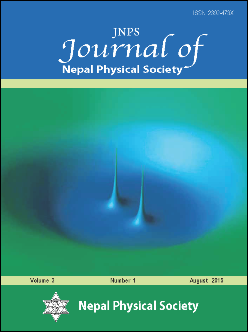Electronic and Magnetic Properties of Double Perovskites Nd2MgIrO6
DOI:
https://doi.org/10.3126/jnphyssoc.v3i1.14442Keywords:
First-principles calculations, antiferromagnetism, Mott-Hubbard insulator.Abstract
We have studied the electronic and magnetic properties of double perovskites Nd2MgIrO6 by means of full-potential linearized augmented plane wave (FP-LAPW) method based on density-functional theory (DFT). For the exchange-correlation potential, generalized gradient approximation (GGA) has been used. Based on our DFT calculations, Nd2MgIrO6 is found to have an antiferromagnetic (AFM) ground state. The material shows Mott-Hubbard type insulator, which is observed to occur due to strong correlation in Nd-4f and Ir-5d states in addition to large crystal distortion, observed in the system. Strong hybridization between O-2p, Ir-5d and Nd-4f electrons are observed from the density of states findings. Our results shows that the 5d electrons of Ir hybridize strongly with O-2p states close to the Fermi level giving rise to the insulating state with a Mott-gap of ~0.9 eV in Nd2MgIrO6. Our study suggests that the total magnetic moment reduces to 5.0 μB per formula unit as a result of itinerant super-exchange rather than the exchange interaction involving individual ions of Nd and Ir atoms.
Journal of Nepal Physical Society Vol.3(1) 2015: 50-54
Downloads
Downloads
Published
How to Cite
Issue
Section
License
All right reserved. No part of this Journal may be reproduced in any form or by any electronic or mechanical means, including information storage and retrieval system, without permission in writing from the publisher, except by a reviewer who may quote brief passage in a review. The views and interpretation in this journal are those of author(s) and they are not attributable to the NPS.




